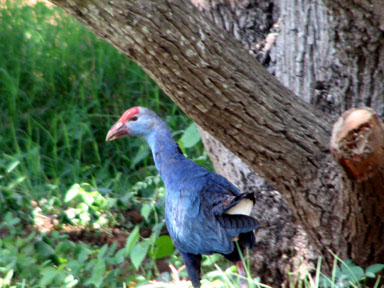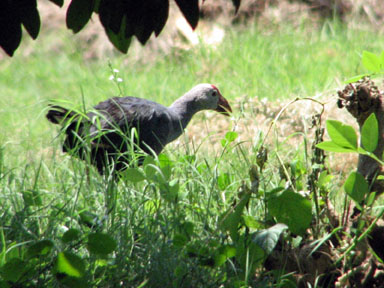Purple Moorhen.( Porphyrio porphyrio.)
RagooRao
To keep the continuity of waterfowl and shore birds, this month I have chosen the shy Purple moorhen.
The marshy lands and swamps attract a lot of birds specialised to that environment. The marshlands and swamps are
bordered usually by tall reeds and swamp grasses. This is the perfect environment for a domestic hen sized bird, shiny Purple in color with a red patch on the bald head and red beak with long red legs clumsily moving along the shore line or among the reeds.
This is the Purple Moorhen. The male is a glistening purple color and the female is a little duller than the male with greyish-purple color. This bird can be seen clumsily moving around with calculated gait and the short stubby
tail flicking at every step.
It is a very shy bird and hides itself among the cat-tail reeds at the slightest disturbance. Pairs are often seen
and sometimes a party of them can be seen foraging at close fields adjoining the swamps. It is in the group of Rails, and has the characters of all rails. 
Distribution is throughout the country and an interesting bird to study, which need lot of stealth.
Sometimes these birds are very amusing to watch as they try to clamber up the reeds awkwardly.
They forage on insects, mollusks, water beetles, and water-plant shoots. In their foraging sprees they sometimes invade
the close by paddy fields and graze on the tender rice-shoots. This is not much of a problem as the farmer’s presence is enough to send them off scuttling for cover among the reeds.
 The courtship display is more like children playing catch-me-if-you-can game. Their calls are also amusing as
they do not keep to any standard call sometimes cackling like hens, sometimes hooting, sometimes hissing and shrieking. The male is seen to entice a female by holding a piece of reed in his beaks and offering it to females.
The courtship display is more like children playing catch-me-if-you-can game. Their calls are also amusing as
they do not keep to any standard call sometimes cackling like hens, sometimes hooting, sometimes hissing and shrieking. The male is seen to entice a female by holding a piece of reed in his beaks and offering it to females.
The nesting season is from June to September. The nest is large pad of reed leaves on a floating mass or hidden inside
the reed beds. 3 to 6 eggs are laid with pale yellowish color and blotched or spotted with reddish brown.
Whether both the sexes share all domestic duties is a thing to be studied and discovered.
More study is needed to ascertain more life habits of these shy birds.
The only threat to these marvelous birds is the pollution of these still-water bodies as agricultural toxic wastes are led to the marshes and in urban surroundings the sewage water led to such swamps and jheels.